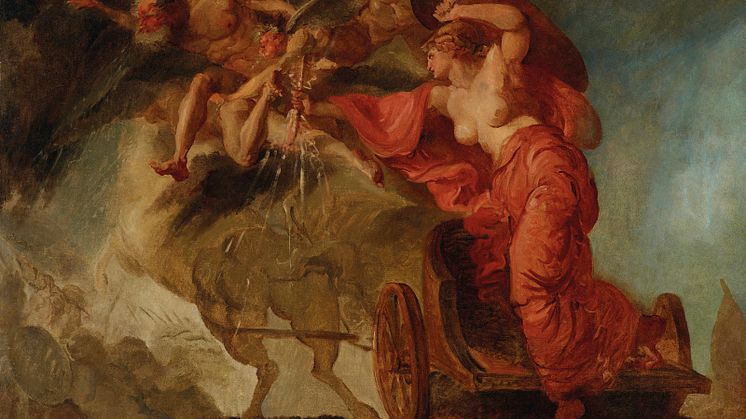
Press release -
New acquisition: An Allegory of War by Louis Masreliez
Nationalmuseum has acquired An Allegory of War, a painting by Louis Masreliez originally intended to be one of two overdoor pieces for King Gustav III’s bedchamber in the royal palace in Stockholm. The work is of major significance, marking a transition in the artist’s oeuvre from epic historical scenes to more decorative works.
As one of the leading painters and interior designers of the Gustavian period, Louis Masreliez (1748–1810) was equal to the task. Born in Paris, he arrived in Stockholm at the age of five when his father, the ornamental sculptor Adrien Masreliez, was hired to work on the new palace. Young Louis soon proved to be something of an artistic child prodigy. He received the best possible education, which culminated in 1769 in a travel scholarship. Via Paris he travelled to Rome, where he studied for the next 12 years. In this cosmopolitan environment Masreliez mixed with the leading artists of the time, found his niche in the emerging neoclassical style, and drew many studies of Classical and Renaissance motifs to serve as reference material.
On returning to Stockholm in 1782, Masreliez was well equipped to oversee the redecoration of Gustav III’s private apartment at the palace in keeping with contemporary neoclassical interior design trends. Neoclassicism blended the grotesque decorative style of the Renaissance with features inspired by ancient Rome. The best-known example in Sweden today is the interior decoration of Gustav III’s pavilion at Haga. Meanwhile, Masreliez also had a solid grounding in historical painting, the task he was originally destined for in the service of the crown. Here too, he combined various influences from the great masters, all packaged in an elegant neoclassical form. This can be clearly seen in An Allegory of War.
It is conceivable that Gustav III himself chose the subject matter for the two overdoor paintings in his bedchamber. The king was heavily involved and had his own ideas regarding the interior decoration of royal properties, as contemporary sources attest. An Allegory of War and its counterpart, An Allegory of Peace, would promote the image of the king as defender of the realm and ultimate guarantor of peace. The topic was highly relevant, as the works were created in the immediate aftermath of Sweden’s 1788–90 war against Russia. An Allegory of War depicts Minerva alighting from her horse-drawn chariot, holding a shield in one hand and the lightning bolt of Zeus in the other. Above her hovers Boreas, god of the north wind, accompanied by winged zephyrs with snowflakes emanating from their mouths. It is both a dramatic composition and an unusually powerful painting with its grand, sweeping lines. The somewhat explosive colour palette, dominated by earth tones and martial red, reinforces the subject matter.
From an inscription on a preliminary sketch by Masreliez, we know that this image represented the Swedish victory at the battle of Narva in 1700, an event to which Gustav III frequently alluded, since it had secured Sweden’s position as a great power for some years. If Karl XII was explicitly presented here as the warrior king, then Gustav III would implicitly be the prince of peace in the counterpart image. A preliminary study in oils for An Allegory of Peace has been in Nationalmuseum’s collection since 1917. It is believed the ensemble was never completed following the king’s death in 1792, and instead the artist retained ownership of the works.
Nationalmuseum receives no state funds with which to acquire design, applied art and artwork; instead the collections are enriched through donations and gifts from private foundations and trusts. Thanks to a generous donation from the Friends of Nationalmuseum, the museum has been able to repatriate the magnificent Masreliez work to Sweden.
Inventory number
Louis Masreliez: An Allegory of War, c.1790–92. Oil on canvas. NM 7613.
Media enquiries
Magnus Olausson, director of collections, magnus.olausson@nationalmuseum.se, +46 8 5195 4371
Hanna Tottmar, head of press, press@nationalmuseum.se, +46 8 5195 4400
Categories
Nationalmuseum is Sweden’s museum of art and design. The collections include paintings, sculpture, drawings and graphic art from the 16th century up to the beginning of the 20th century and the collection of applied art and design up to the present day. The museum building was closed for renovation for five years and reopened in autumn 2018.

